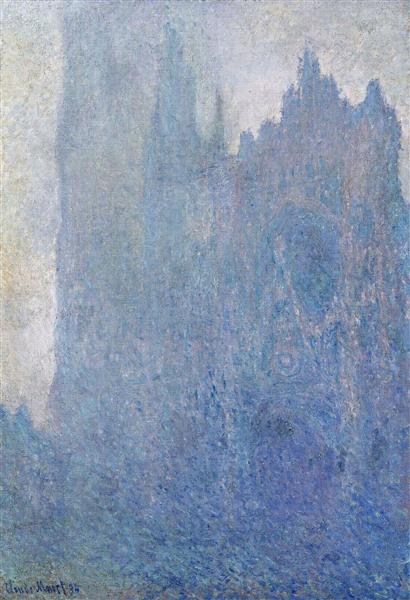Description
The painting "Cathedral of Rouen in the fog" by Claude Monet, created in 1894, is a work that seeks to capture not only the architectural structure of the cathedral, but also the intangible atmosphere that surrounds it. Monet, a pioneer of impressionism, is known for its ability to synthesize light and color in its works, and this painting is a remarkable manifestation of those qualities. Through a careful choice of tones and application technique, the artist offers an almost ethereal vision of the cathedral, transforming it into a subject that transcends its materiality.
As for the composition, the cathedral occupies the central part of the painting, representing a focal point marked in a hacking environment. The subtle fusion between the gray stone of the building and the variations of colors that surround it creates a feeling of depth and mystery. Monet abbreviates architectural details in favor of a more abstract representation, underlining how atmospheric conditions can alter the perception of a fixed object. The fog that surrounds the cathedral is not an obstacle, but a way of highlighting its contours, an ingenious use of the void that allows the viewer to feel the changing environment of the scene, almost as if one could feel the humidity of the air.
The predominance of blue, gray and white suggests an introspective and melancholic atmosphere, promoting the viewer's experience while inviting contemplation. This color palette is characteristic of Monet's style, who experienced with the effects of light on nature and architecture. Here, the FOG of the morning seems to wrap the cathedral in a kind of soft mantle, which defies the traditional rules of representation that would normally require a more defined tone.
Unlike many works that portray the Cathedral of Rouen in its splendor, "Rouen Cathedral in the fog" offers us a fleeting moment, a moment chained to the memory of an experiential experience. Monet composed this series of paintings Based on the cathedral during his stay in Rouen, where he dedicated himself to capture his facade in different conditions of light and climate. This work is registered within a broader series in which Monet uses the cathedral as a portal to explore time, light and perception.
It is fascinating to consider that, although the cathedral is the main theme, there are no visible characters in the painting, which amplifies the viewer's approach in the dialogue between the structure and its surroundings. The absence of human figures highlights the loneliness and stillness of the place, a contrast to the vibrant activities of urban life that would normally have surrounded such an iconic building.
Monet, through its loose brushstroke technique and its understanding of color, achieves a work that is both a portrait of the cathedral and a representation of the emotional experience it evokes. Thus emerges a connection between architecture and landscape, where the cathedral becomes a symbol of a poetic moment, merging with the atmospheric experiences of the environment. "Cathedral of Rouen in the fog" is, therefore, a testament of Monet's talent to capture the essence of a place, and at the same time, deepen the subjective perception of the viewer, achieved through the masterful use of color and the atmosphere. In this work, Monet not only paints a cathedral; It paints an experience, a moment, an emotion, and invites us to share that moment in time.
KUADROS ©, a famous paint on your wall.
Hand-made oil painting reproductions, with the quality of professional artists and the distinctive seal of KUADROS ©.
Reproduction service paintings With a guarantee of satisfaction. If you are not completely satisfied with the replica of your painting, we refund your money 100%.

